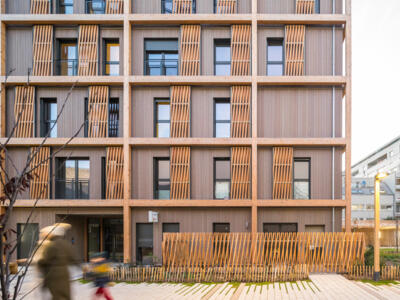Wood, a renewable material that promotes sustainable development
The challenges of global warming are very real. Choosing wood for construction means taking action in favour of sustainable development and supporting sustainable forest management.
Choosing wood for your construction helps combat the greenhouse effect and global warming. Even after it is cut, wood continues to store CO2. This ability to store carbon is very interesting in construction because a building made mainly of wood will store more carbon than it will emit during its lifetime.
Wood construction promotes the growth of new trees through the felling of mature trees, thereby helping to increase forest capital.
Unlike other building materials, wood is a clean and renewable material.
Wood, a material of the future for urban development
Wood is a high-performance material that can be easily adapted to different architectural constraints, whether for new construction or renovation.
Wood is a lightweight and high-performance material. Lighter than traditional masonry construction, wood opens up a wide range of architectural possibilities and is more easily adapted to complex projects. New technologies developed in the field of wood and construction offer a wide range of possibilities.
Wood is an attractive material. It blends harmoniously into its surroundings, bringing urban spaces to life. Wood combines perfectly with other building materials and is equally suited to modern buildings and the renovation of more traditional structures.
Wood construction for healthy living and optimal thermal insulation
A natural and living material, wood ensures everyday comfort and a healthy environment.
Wood is a natural and living material. It regulates humidity levels and maintains a constant level of hygrometry in the home. Wooden homes and buildings are also known to reduce the risk of allergies and respiratory problems.
Wood provides thermal comfort by regulating the temperature of buildings in both summer and winter. This saves energy and ensures long-lasting comfort.
Contrary to popular belief, wood is highly fire-resistant and easily adapted to buildings open to the public.
Wood: a material that combines quality, affordability and performance
Wooden buildings are an undeniable asset for public building projects and for meeting regional challenges.
Wood for faster construction sites. Dry construction uses materials such as wood that do not require water and are usually pre-assembled in a workshop to save time and money. Wood construction projects are therefore assembled more quickly, resulting in significant economic and time savings for local authorities.
Wood for energy savings. Wood is a bio-based material that meets regulatory requirements in terms of insulation. As seen above, its thermal regulation properties provide comfort in the home and significant energy savings.
Wood for easy maintenance. Structural timber for the frame of a building or house requires no maintenance. Building elements such as wood cladding require very little maintenance, depending on the type of finish chosen.
What are the disadvantages of installing exterior wood cladding?
Wood is a living material. Without special maintenance, it will naturally turn grey. While this grey appearance may appeal to most wood lovers, others may find it unattractive. To revive the original shades of a façade, maintenance will therefore be required. Today, there are high-performance, low-maintenance wood façade solutions available. At Sivalbp, we develop aesthetically durable wood cladding that requires minimal maintenance over time. The advantage of our Sivalbp saturator finishes is that they require very little maintenance over time. Our saturated finishes do not flake and do not require stripping or sanding. Maintenance costs are therefore controlled and predictable.
Wood species according to geographical area. Although wood cladding is generally suitable for all geographical areas, it is nevertheless advisable to choose the right species for your geographical area to ensure optimal ageing over time. In the UK, there are five main types of climate: oceanic, temperate, continental, mountain and Mediterranean. Each has its own characteristics and it is important to choose your wood species accordingly. For more advice on choosing the right species for your geographical area, contact our wood experts.
Fire safety regulations. Certain specific fire safety requirements must be met, particularly when constructing multi-storey wooden buildings. For more information, see our article on the fire resistance of wood cladding.
Wood is a material of the future in building construction and renovation, offering many advantages: it is environmentally friendly, high quality, promotes healthy living and provides optimal thermal insulation. Do you have a construction or renovation project involving wood cladding? Contact the experts at Sivalbp for advice.









